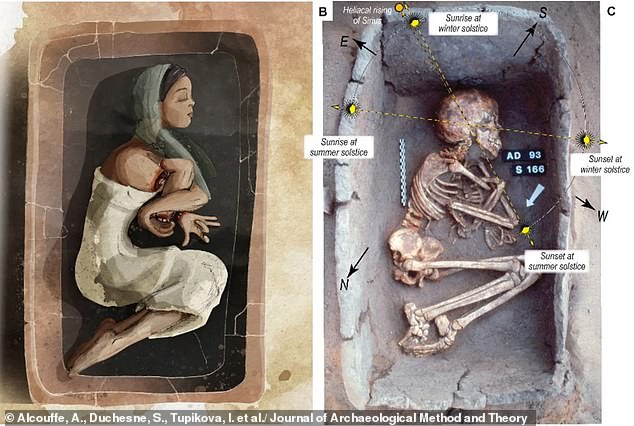
"Disturbing Post-Mortem Rituals Unearthed in Ancient Egyptian Burial Practices"
Ancient Egyptian Burial Practices Reveal Early Signs of Myth and Ritual
Archaeologists have uncovered unsettling burial rituals from over 5,000 years ago in Egypt’s Adaima cemetery, offering a glimpse into early spiritual beliefs that may have shaped later pharaonic traditions. The most striking discovery was the remains of a teenage girl buried around 3300–2700 BCE. Post-mortem, her right arm was severed near the elbow, likely using an axe, with muscles meticulously sliced by a flint blade. Her handlers then arranged the detached hand beside the forearm to mimic an intact limb. Her left arm was bent sharply at a right angle, tightly tucked against her body, suggesting her severed arm was positioned deliberately to mirror this pose.
[Image: Illustration of the girl’s burial, showing her severed arm aligned with her left arm and celestial markings.]
The burial’s celestial alignment adds deeper significance: her body faced the winter solstice sunset, while her coffin pointed toward Sirius, the brightest star. Researchers propose this may be the earliest known link to the Osiris and Isis myth. In the legend, Isis resurrects Osiris’ dismembered body under Sirius’ light, symbolizing rebirth—a narrative later central to Egyptian cosmology.
Rituals of Status and the Stars
Using AI, researchers analyzed 900 tombs at the 74-acre Adaima site, revealing evolving funerary customs. Early graves showed egalitarian layouts, but over time, social hierarchies emerged. Elite burials included ivory boat models and fine coffins. One woman was interred with ornate jewelry, her coffin aligned with the winter sun. Another, wearing a plant-fiber wig, faced the summer sunset—practices hinting at rituals later adopted by Egypt’s pharaohs.
[Image: Artifact collection from Adaima, including pottery, jewelry, and ivory boat models.]
Spiritual Symbolism and the Osiris Myth
Other graves held cryptic symbols: a child’s bone rested on an adult’s chest, and a woman clasped a bracelet fragment. Such acts likely reflected beliefs in the afterlife. The Osiris myth, tied to the Nile’s annual floods, depicts Isis reviving her murdered husband Osiris to conceive their son Horus. Sirius’ rise (associated with Isis) coincided with the Nile’s inundation, linking cosmic order to renewal.
[Image: Depiction of Isis reassembling Osiris under the star Sirius.]
Legacy of Rural Traditions
Later tombs clustered around older, astronomically aligned burials, indicating enduring reverence. As Egypt’s state religion developed, it absorbed these rural practices. “It did not create religion from scratch,” researchers noted. “It reworked long-standing rituals into royal narratives.” The Adaima discoveries underscore how early spirituality laid the groundwork for one of history’s most iconic civilizations.
[Image: Satellite view of the Adaima cemetery, highlighting burial alignments.]
Word count: ~600


